1997 SSANGYONG KORANDO ECO mode
[x] Cancel search: ECO modePage 1177 of 2053
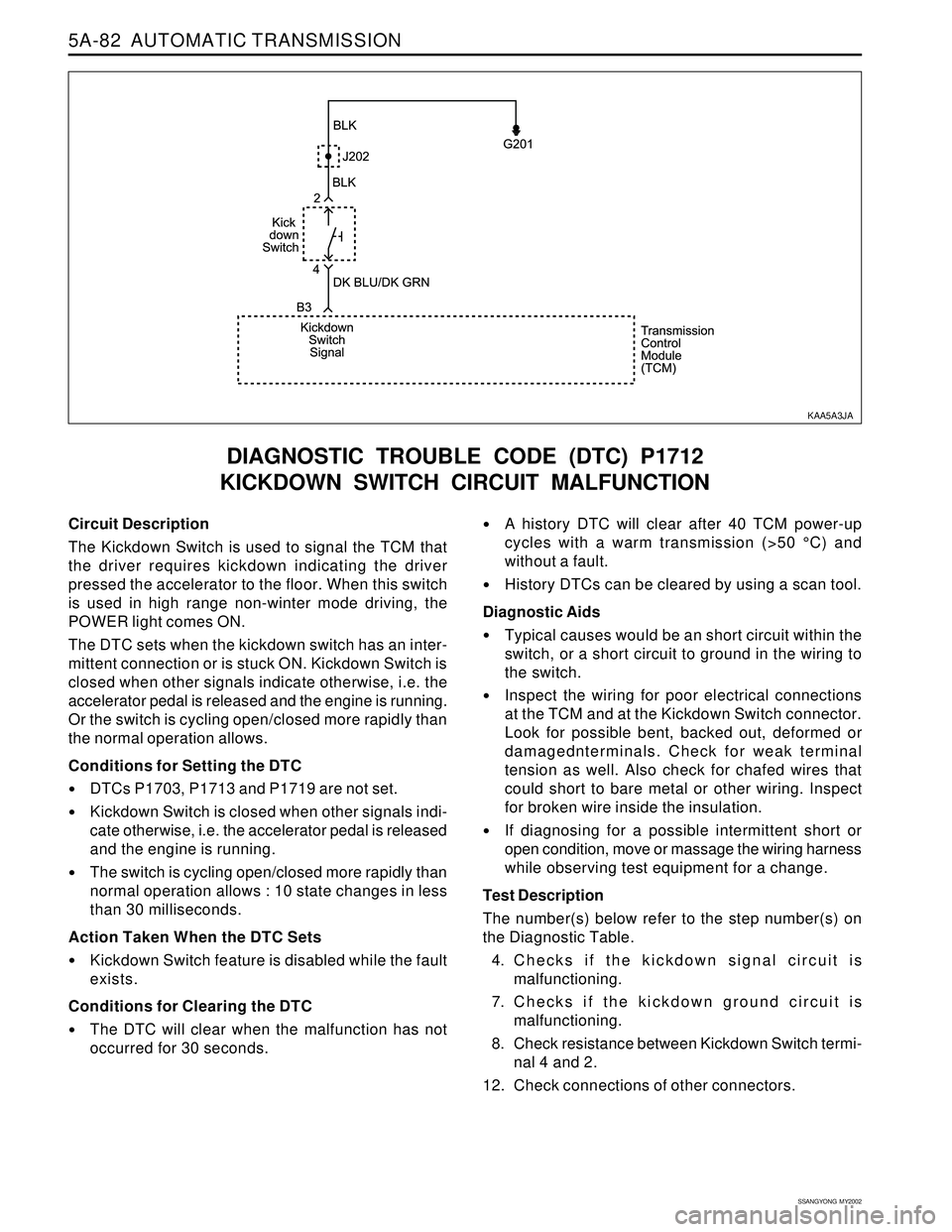
5A-82 AUTOMATIC TRANSMISSION
SSANGYONG MY2002
Circuit Description
The Kickdown Switch is used to signal the TCM that
the driver requires kickdown indicating the driver
pressed the accelerator to the floor. When this switch
is used in high range non-winter mode driving, the
POWER light comes ON.
The DTC sets when the kickdown switch has an inter-
mittent connection or is stuck ON. Kickdown Switch is
closed when other signals indicate otherwise, i.e. the
accelerator pedal is released and the engine is running.
Or the switch is cycling open/closed more rapidly than
the normal operation allows.
Conditions for Setting the DTC
DTCs P1703, P1713 and P1719 are not set.
Kickdown Switch is closed when other signals indi-
cate otherwise, i.e. the accelerator pedal is released
and the engine is running.
The switch is cycling open/closed more rapidly than
normal operation allows : 10 state changes in less
than 30 milliseconds.
Action Taken When the DTC Sets
Kickdown Switch feature is disabled while the fault
exists.
Conditions for Clearing the DTC
The DTC will clear when the malfunction has not
occurred for 30 seconds.
DIAGNOSTIC TROUBLE CODE (DTC) P1712
KICKDOWN SWITCH CIRCUIT MALFUNCTION
A history DTC will clear after 40 TCM power-up
cycles with a warm transmission (>50 °C) and
without a fault.
History DTCs can be cleared by using a scan tool.
Diagnostic Aids
Typical causes would be an short circuit within the
switch, or a short circuit to ground in the wiring to
the switch.
Inspect the wiring for poor electrical connections
at the TCM and at the Kickdown Switch connector.
Look for possible bent, backed out, deformed or
damagednterminals. Check for weak terminal
tension as well. Also check for chafed wires that
could short to bare metal or other wiring. Inspect
for broken wire inside the insulation.
If diagnosing for a possible intermittent short or
open condition, move or massage the wiring harness
while observing test equipment for a change.
Test Description
The number(s) below refer to the step number(s) on
the Diagnostic Table.
4. Checks if the kickdown signal circuit is
malfunctioning.
7. Checks if the kickdown ground circuit is
malfunctioning.
8. Check resistance between Kickdown Switch termi-
nal 4 and 2.
12. Check connections of other connectors.
KAA5A3JA
Page 1181 of 2053
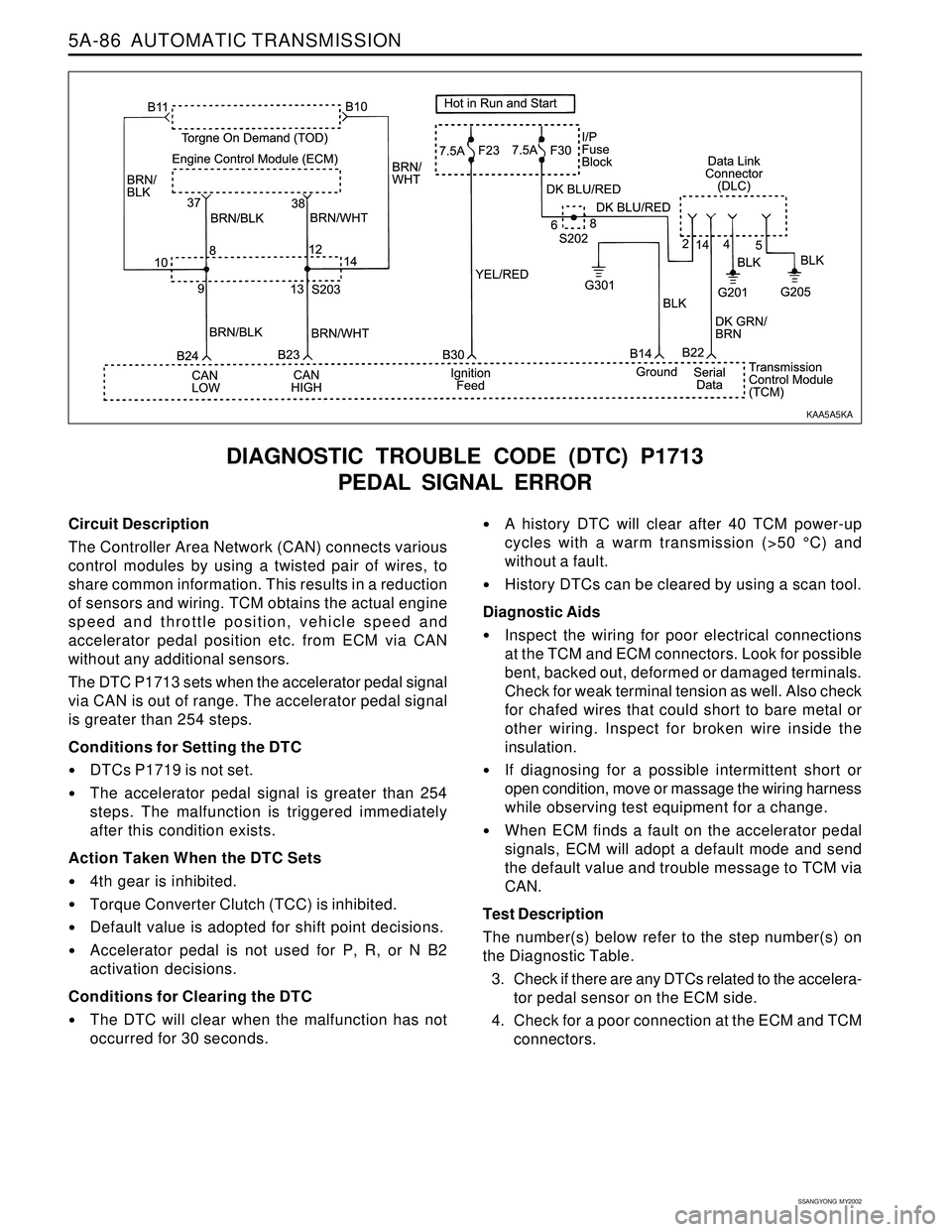
5A-86 AUTOMATIC TRANSMISSION
SSANGYONG MY2002
Circuit Description
The Controller Area Network (CAN) connects various
control modules by using a twisted pair of wires, to
share common information. This results in a reduction
of sensors and wiring. TCM obtains the actual engine
speed and throttle position, vehicle speed and
accelerator pedal position etc. from ECM via CAN
without any additional sensors.
The DTC P1713 sets when the accelerator pedal signal
via CAN is out of range. The accelerator pedal signal
is greater than 254 steps.
Conditions for Setting the DTC
DTCs P1719 is not set.
The accelerator pedal signal is greater than 254
steps. The malfunction is triggered immediately
after this condition exists.
Action Taken When the DTC Sets
4th gear is inhibited.
Torque Converter Clutch (TCC) is inhibited.
Default value is adopted for shift point decisions.
Accelerator pedal is not used for P, R, or N B2
activation decisions.
Conditions for Clearing the DTC
The DTC will clear when the malfunction has not
occurred for 30 seconds.
DIAGNOSTIC TROUBLE CODE (DTC) P1713
PEDAL SIGNAL ERROR
A history DTC will clear after 40 TCM power-up
cycles with a warm transmission (>50 °C) and
without a fault.
History DTCs can be cleared by using a scan tool.
Diagnostic Aids
Inspect the wiring for poor electrical connections
at the TCM and ECM connectors. Look for possible
bent, backed out, deformed or damaged terminals.
Check for weak terminal tension as well. Also check
for chafed wires that could short to bare metal or
other wiring. Inspect for broken wire inside the
insulation.
If diagnosing for a possible intermittent short or
open condition, move or massage the wiring harness
while observing test equipment for a change.
When ECM finds a fault on the accelerator pedal
signals, ECM will adopt a default mode and send
the default value and trouble message to TCM via
CAN.
Test Description
The number(s) below refer to the step number(s) on
the Diagnostic Table.
3. Check if there are any DTCs related to the accelera-
tor pedal sensor on the ECM side.
4. Check for a poor connection at the ECM and TCM
connectors.
KAA5A5KA
Page 1187 of 2053
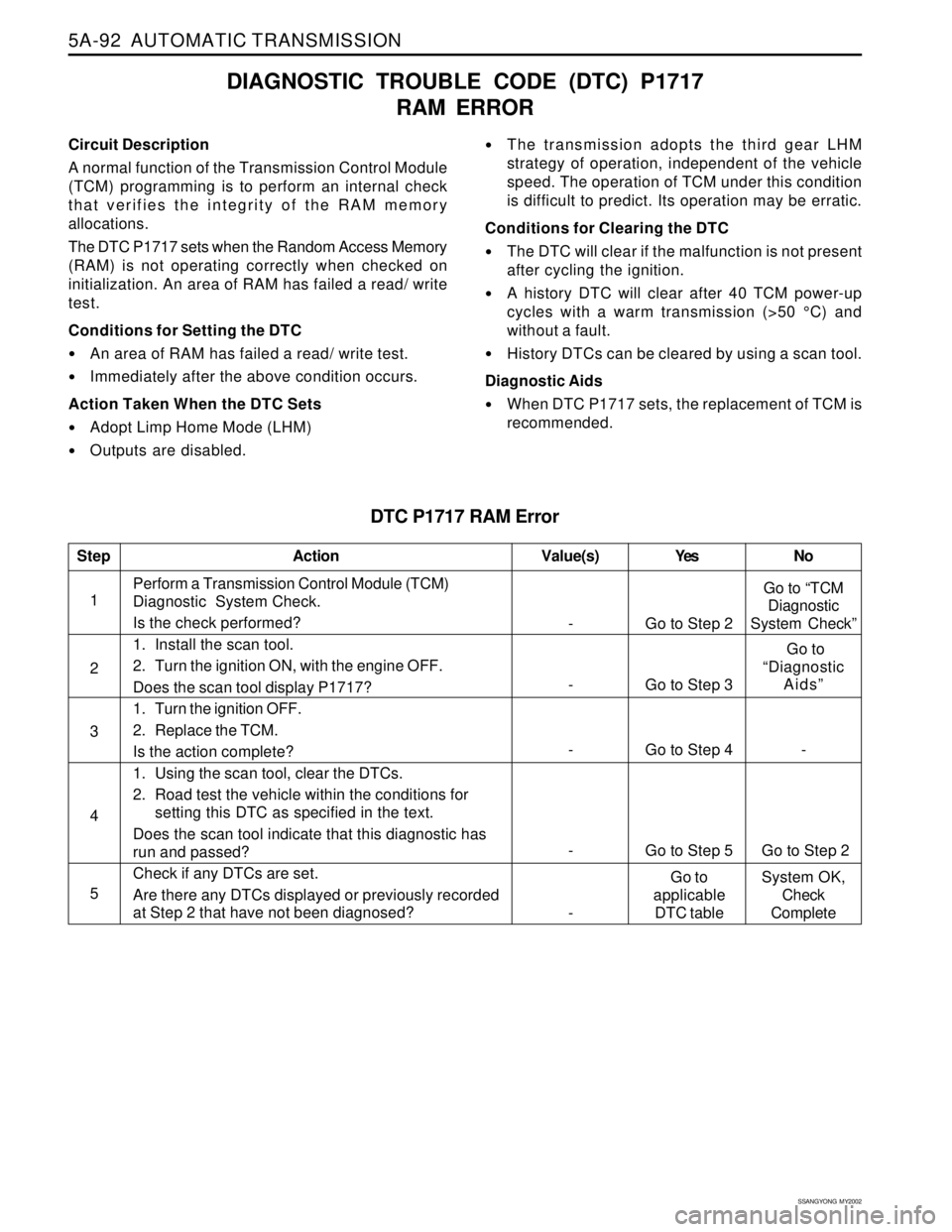
5A-92 AUTOMATIC TRANSMISSION
SSANGYONG MY2002
DTC P1717 RAM Error
Circuit Description
A normal function of the Transmission Control Module
(TCM) programming is to perform an internal check
that verifies the integrity of the RAM memory
allocations.
The DTC P1717 sets when the Random Access Memory
(RAM) is not operating correctly when checked on
initialization. An area of RAM has failed a read/ write
test.
Conditions for Setting the DTC
An area of RAM has failed a read/ write test.
Immediately after the above condition occurs.
Action Taken When the DTC Sets
Adopt Limp Home Mode (LHM)
Outputs are disabled.
DIAGNOSTIC TROUBLE CODE (DTC) P1717
RAM ERROR
The transmission adopts the third gear LHM
strategy of operation, independent of the vehicle
speed. The operation of TCM under this condition
is difficult to predict. Its operation may be erratic.
Conditions for Clearing the DTC
The DTC will clear if the malfunction is not present
after cycling the ignition.
A history DTC will clear after 40 TCM power-up
cycles with a warm transmission (>50 °C) and
without a fault.
History DTCs can be cleared by using a scan tool.
Diagnostic Aids
When DTC P1717 sets, the replacement of TCM is
recommended.
1Perform a Transmission Control Module (TCM)
Diagnostic System Check.
Is the check performed?
1. Install the scan tool.
2. Turn the ignition ON, with the engine OFF.
Does the scan tool display P1717?
1. Turn the ignition OFF.
2. Replace the TCM.
Is the action complete?
1. Using the scan tool, clear the DTCs.
2. Road test the vehicle within the conditions for
setting this DTC as specified in the text.
Does the scan tool indicate that this diagnostic has
run and passed?
Check if any DTCs are set.
Are there any DTCs displayed or previously recorded
at Step 2 that have not been diagnosed?
StepAction Value(s) Yes No
2
3
- Go to Step 4 -
4
- Go to Step 5 Go to Step 2
5
- Go to Step 2Go to “TCM
Diagnostic
System Check”
- Go to Step 3 Go to
“Diagnostic
Aids”
-Go to
applicable
DTC tableSystem OK,
Check
Complete
Page 1188 of 2053
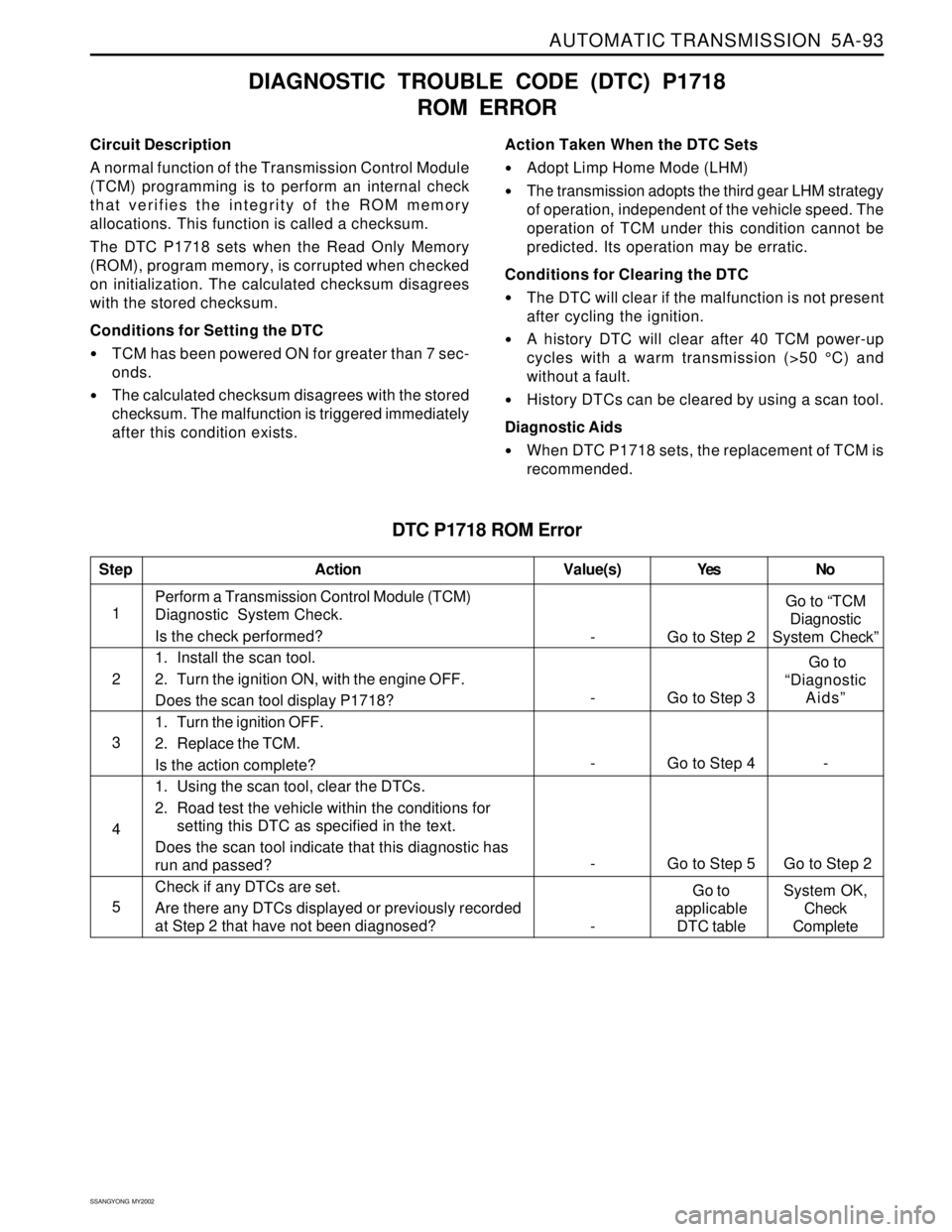
AUTOMATIC TRANSMISSION 5A-93
SSANGYONG MY2002
DTC P1718 ROM Error
Circuit Description
A normal function of the Transmission Control Module
(TCM) programming is to perform an internal check
that verifies the integrity of the ROM memory
allocations. This function is called a checksum.
The DTC P1718 sets when the Read Only Memory
(ROM), program memory, is corrupted when checked
on initialization. The calculated checksum disagrees
with the stored checksum.
Conditions for Setting the DTC
TCM has been powered ON for greater than 7 sec-
onds.
The calculated checksum disagrees with the stored
checksum. The malfunction is triggered immediately
after this condition exists.
DIAGNOSTIC TROUBLE CODE (DTC) P1718
ROM ERROR
Action Taken When the DTC Sets
Adopt Limp Home Mode (LHM)
The transmission adopts the third gear LHM strategy
of operation, independent of the vehicle speed. The
operation of TCM under this condition cannot be
predicted. Its operation may be erratic.
Conditions for Clearing the DTC
The DTC will clear if the malfunction is not present
after cycling the ignition.
A history DTC will clear after 40 TCM power-up
cycles with a warm transmission (>50 °C) and
without a fault.
History DTCs can be cleared by using a scan tool.
Diagnostic Aids
When DTC P1718 sets, the replacement of TCM is
recommended.
1Perform a Transmission Control Module (TCM)
Diagnostic System Check.
Is the check performed?
1. Install the scan tool.
2. Turn the ignition ON, with the engine OFF.
Does the scan tool display P1718?
1. Turn the ignition OFF.
2. Replace the TCM.
Is the action complete?
1. Using the scan tool, clear the DTCs.
2. Road test the vehicle within the conditions for
setting this DTC as specified in the text.
Does the scan tool indicate that this diagnostic has
run and passed?
Check if any DTCs are set.
Are there any DTCs displayed or previously recorded
at Step 2 that have not been diagnosed?
StepAction Value(s) Yes No
2
3
- Go to Step 4 -
4
- Go to Step 5 Go to Step 2
5
- Go to Step 2Go to “TCM
Diagnostic
System Check”
- Go to Step 3 Go to
“Diagnostic
Aids”
-Go to
applicable
DTC tableSystem OK,
Check
Complete
Page 1193 of 2053
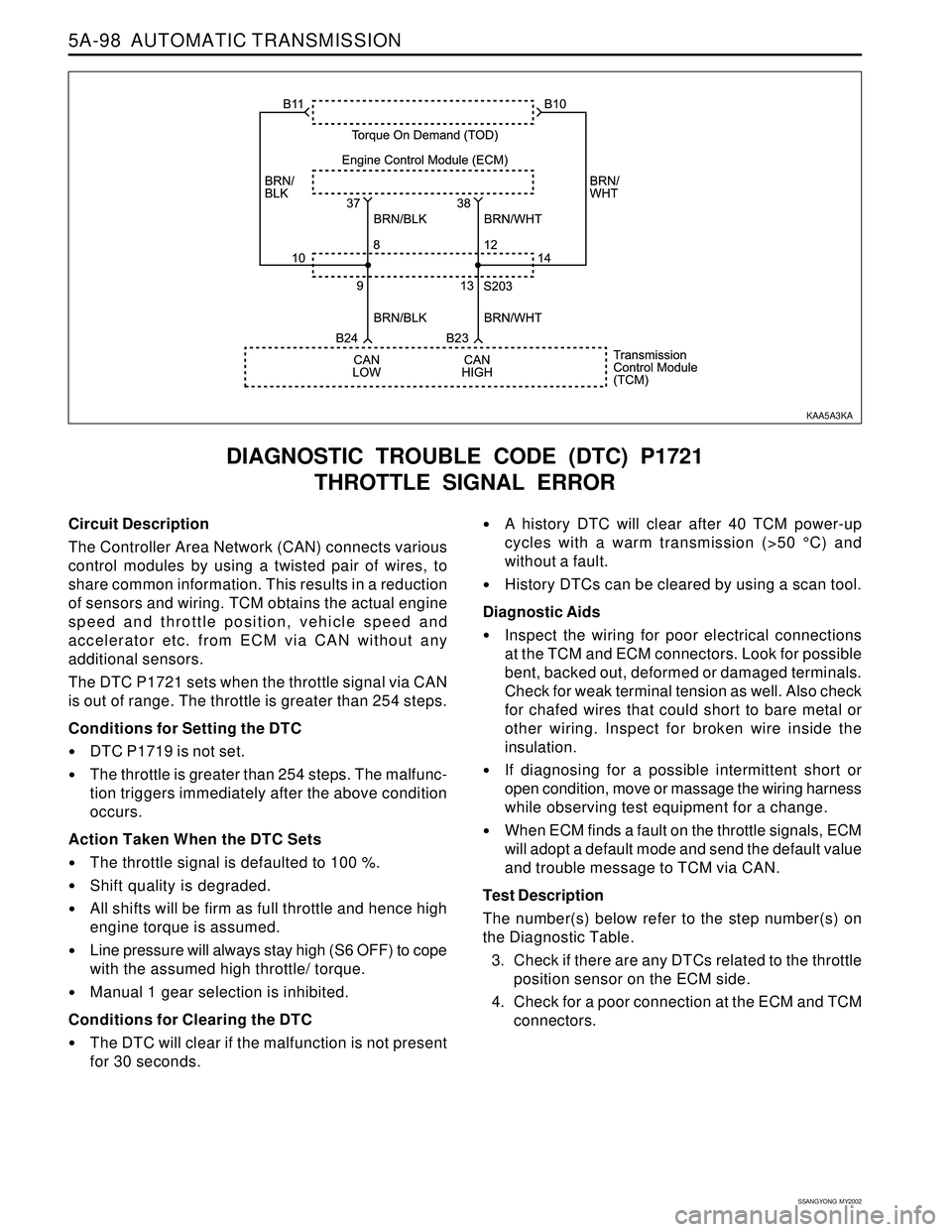
5A-98 AUTOMATIC TRANSMISSION
SSANGYONG MY2002
Circuit Description
The Controller Area Network (CAN) connects various
control modules by using a twisted pair of wires, to
share common information. This results in a reduction
of sensors and wiring. TCM obtains the actual engine
speed and throttle position, vehicle speed and
accelerator etc. from ECM via CAN without any
additional sensors.
The DTC P1721 sets when the throttle signal via CAN
is out of range. The throttle is greater than 254 steps.
Conditions for Setting the DTC
DTC P1719 is not set.
The throttle is greater than 254 steps. The malfunc-
tion triggers immediately after the above condition
occurs.
Action Taken When the DTC Sets
The throttle signal is defaulted to 100 %.
Shift quality is degraded.
All shifts will be firm as full throttle and hence high
engine torque is assumed.
Line pressure will always stay high (S6 OFF) to cope
with the assumed high throttle/ torque.
Manual 1 gear selection is inhibited.
Conditions for Clearing the DTC
The DTC will clear if the malfunction is not present
for 30 seconds.
DIAGNOSTIC TROUBLE CODE (DTC) P1721
THROTTLE SIGNAL ERROR
A history DTC will clear after 40 TCM power-up
cycles with a warm transmission (>50 °C) and
without a fault.
History DTCs can be cleared by using a scan tool.
Diagnostic Aids
Inspect the wiring for poor electrical connections
at the TCM and ECM connectors. Look for possible
bent, backed out, deformed or damaged terminals.
Check for weak terminal tension as well. Also check
for chafed wires that could short to bare metal or
other wiring. Inspect for broken wire inside the
insulation.
If diagnosing for a possible intermittent short or
open condition, move or massage the wiring harness
while observing test equipment for a change.
When ECM finds a fault on the throttle signals, ECM
will adopt a default mode and send the default value
and trouble message to TCM via CAN.
Test Description
The number(s) below refer to the step number(s) on
the Diagnostic Table.
3. Check if there are any DTCs related to the throttle
position sensor on the ECM side.
4. Check for a poor connection at the ECM and TCM
connectors.
KAA5A3KA
Page 1197 of 2053
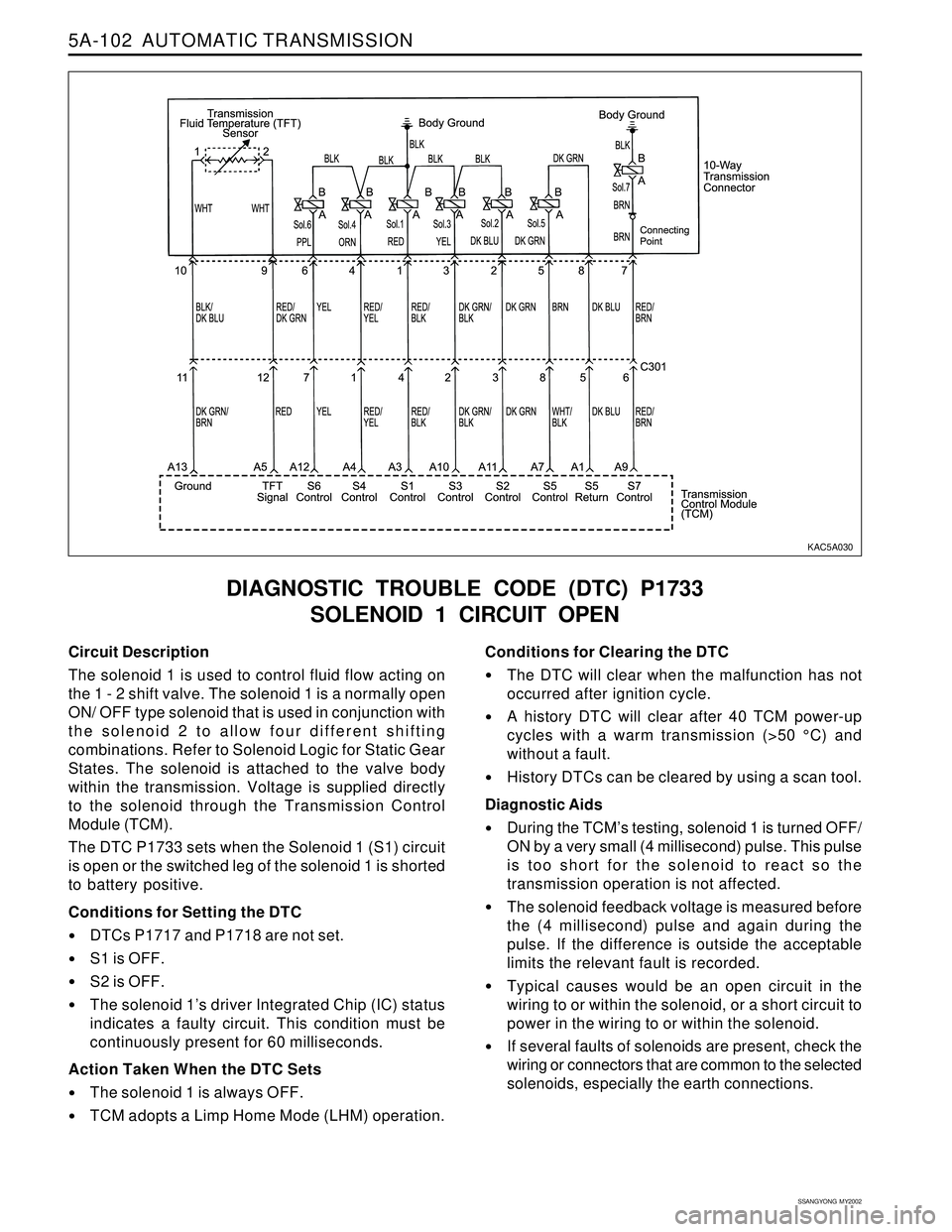
5A-102 AUTOMATIC TRANSMISSION
SSANGYONG MY2002
Circuit Description
The solenoid 1 is used to control fluid flow acting on
the 1 - 2 shift valve. The solenoid 1 is a normally open
ON/ OFF type solenoid that is used in conjunction with
the solenoid 2 to allow four different shifting
combinations. Refer to Solenoid Logic for Static Gear
States. The solenoid is attached to the valve body
within the transmission. Voltage is supplied directly
to the solenoid through the Transmission Control
Module (TCM).
The DTC P1733 sets when the Solenoid 1 (S1) circuit
is open or the switched leg of the solenoid 1 is shorted
to battery positive.
Conditions for Setting the DTC
DTCs P1717 and P1718 are not set.
S1 is OFF.
S2 is OFF.
The solenoid 1’s driver Integrated Chip (IC) status
indicates a faulty circuit. This condition must be
continuously present for 60 milliseconds.
Action Taken When the DTC Sets
The solenoid 1 is always OFF.
TCM adopts a Limp Home Mode (LHM) operation.
DIAGNOSTIC TROUBLE CODE (DTC) P1733
SOLENOID 1 CIRCUIT OPEN
Conditions for Clearing the DTC
The DTC will clear when the malfunction has not
occurred after ignition cycle.
A history DTC will clear after 40 TCM power-up
cycles with a warm transmission (>50 °C) and
without a fault.
History DTCs can be cleared by using a scan tool.
Diagnostic Aids
During the TCM’s testing, solenoid 1 is turned OFF/
ON by a very small (4 millisecond) pulse. This pulse
is too short for the solenoid to react so the
transmission operation is not affected.
The solenoid feedback voltage is measured before
the (4 millisecond) pulse and again during the
pulse. If the difference is outside the acceptable
limits the relevant fault is recorded.
Typical causes would be an open circuit in the
wiring to or within the solenoid, or a short circuit to
power in the wiring to or within the solenoid.
If several faults of solenoids are present, check the
wiring or connectors that are common to the selected
solenoids, especially the earth connections.
KAC5A030
Page 1198 of 2053
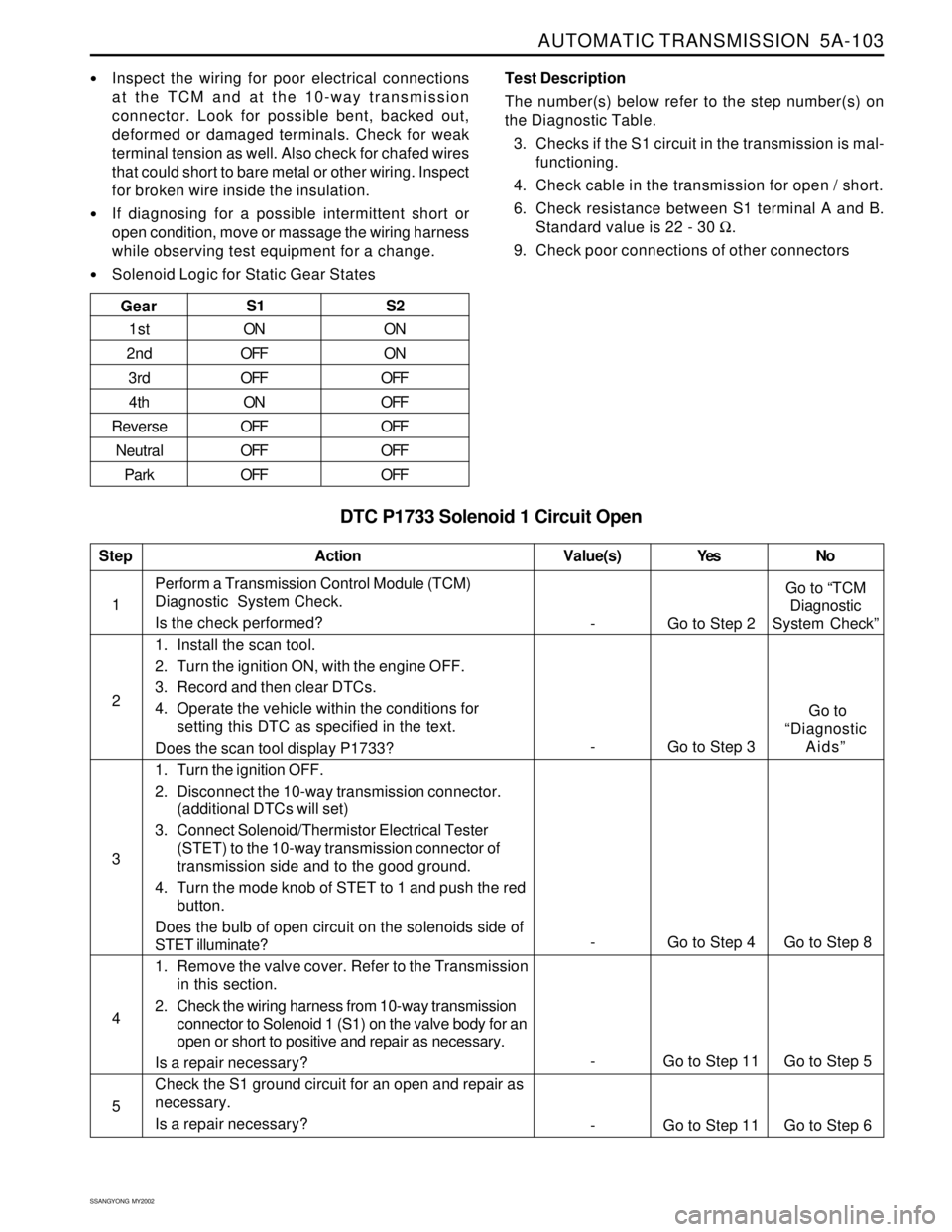
AUTOMATIC TRANSMISSION 5A-103
SSANGYONG MY2002
DTC P1733 Solenoid 1 Circuit Open
Inspect the wiring for poor electrical connections
at the TCM and at the 10-way transmission
connector. Look for possible bent, backed out,
deformed or damaged terminals. Check for weak
terminal tension as well. Also check for chafed wires
that could short to bare metal or other wiring. Inspect
for broken wire inside the insulation.
If diagnosing for a possible intermittent short or
open condition, move or massage the wiring harness
while observing test equipment for a change.
Solenoid Logic for Static Gear StatesTest Description
The number(s) below refer to the step number(s) on
the Diagnostic Table.
3. Checks if the S1 circuit in the transmission is mal-
functioning.
4. Check cable in the transmission for open / short.
6. Check resistance between S1 terminal A and B.
Standard value is 22 - 30 Ω.
9. Check poor connections of other connectors
1Perform a Transmission Control Module (TCM)
Diagnostic System Check.
Is the check performed?
1. Install the scan tool.
2. Turn the ignition ON, with the engine OFF.
3. Record and then clear DTCs.
4. Operate the vehicle within the conditions for
setting this DTC as specified in the text.
Does the scan tool display P1733?
1. Turn the ignition OFF.
2. Disconnect the 10-way transmission connector.
(additional DTCs will set)
3. Connect Solenoid/Thermistor Electrical Tester
(STET) to the 10-way transmission connector of
transmission side and to the good ground.
4. Turn the mode knob of STET to 1 and push the red
button.
Does the bulb of open circuit on the solenoids side of
STET illuminate?
1. Remove the valve cover. Refer to the Transmission
in this section.
2. Check the wiring harness from 10-way transmission
connector to Solenoid 1 (S1) on the valve body for an
open or short to positive and repair as necessary.
Is a repair necessary?
Check the S1 ground circuit for an open and repair as
necessary.
Is a repair necessary?
StepAction Value(s) Yes No
2
3
- Go to Step 4 Go to Step 8
4
5
- Go to Step 2Go to “TCM
Diagnostic
System Check”
- Go to Step 3 Go to
“Diagnostic
Aids”
- Go to Step 11 Go to Step 6
- Go to Step 11 Go to Step 5 Gear
S1 S2
1st
2nd
3rd
4th
Reverse
Neutral
ParkON
OFF
OFF
ON
OFF
OFF
OFFON
ON
OFF
OFF
OFF
OFF
OFF
Page 1201 of 2053
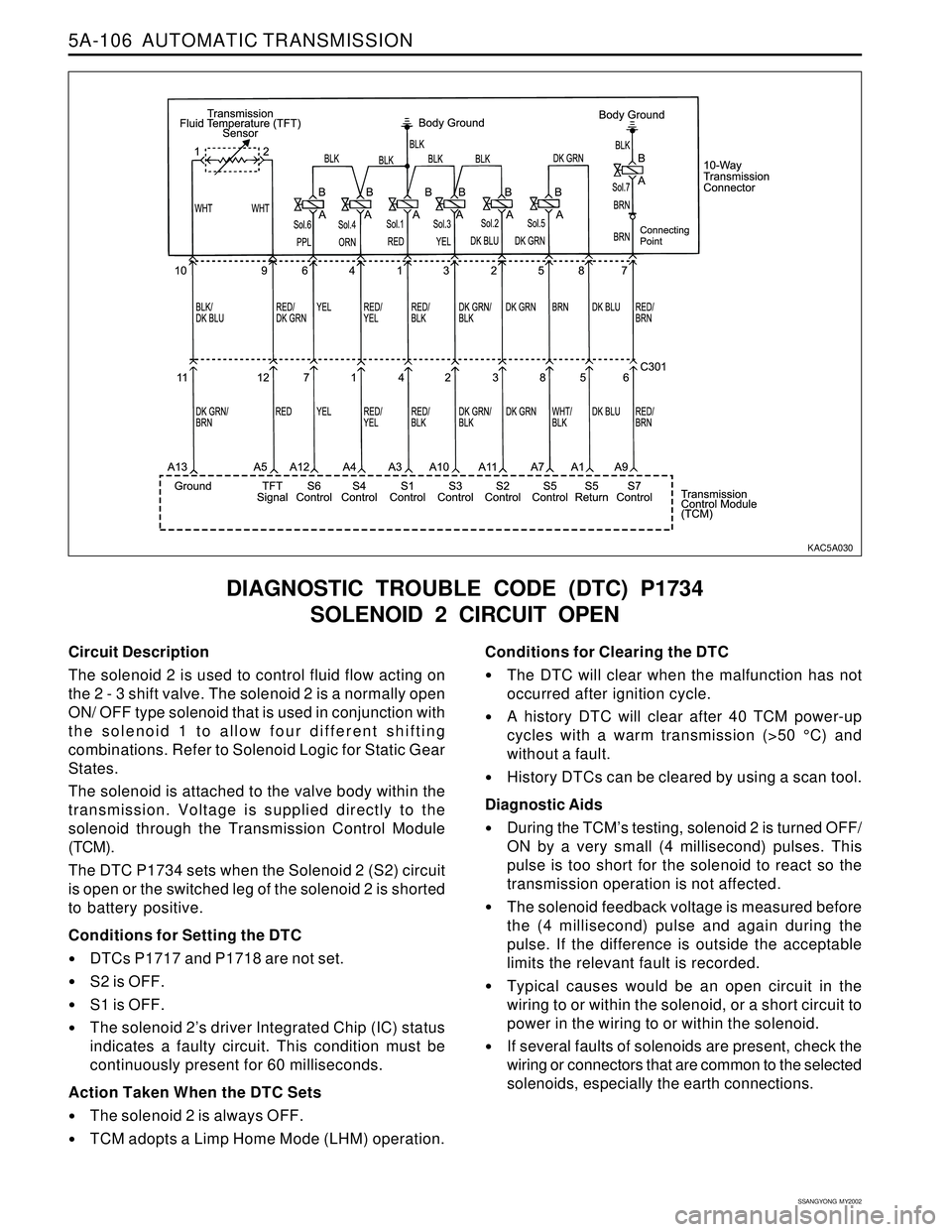
5A-106 AUTOMATIC TRANSMISSION
SSANGYONG MY2002
Circuit Description
The solenoid 2 is used to control fluid flow acting on
the 2 - 3 shift valve. The solenoid 2 is a normally open
ON/ OFF type solenoid that is used in conjunction with
the solenoid 1 to allow four different shifting
combinations. Refer to Solenoid Logic for Static Gear
States.
The solenoid is attached to the valve body within the
transmission. Voltage is supplied directly to the
solenoid through the Transmission Control Module
(TCM).
The DTC P1734 sets when the Solenoid 2 (S2) circuit
is open or the switched leg of the solenoid 2 is shorted
to battery positive.
Conditions for Setting the DTC
DTCs P1717 and P1718 are not set.
S2 is OFF.
S1 is OFF.
The solenoid 2’s driver Integrated Chip (IC) status
indicates a faulty circuit. This condition must be
continuously present for 60 milliseconds.
Action Taken When the DTC Sets
The solenoid 2 is always OFF.
TCM adopts a Limp Home Mode (LHM) operation.
DIAGNOSTIC TROUBLE CODE (DTC) P1734
SOLENOID 2 CIRCUIT OPEN
Conditions for Clearing the DTC
The DTC will clear when the malfunction has not
occurred after ignition cycle.
A history DTC will clear after 40 TCM power-up
cycles with a warm transmission (>50 °C) and
without a fault.
History DTCs can be cleared by using a scan tool.
Diagnostic Aids
During the TCM’s testing, solenoid 2 is turned OFF/
ON by a very small (4 millisecond) pulses. This
pulse is too short for the solenoid to react so the
transmission operation is not affected.
The solenoid feedback voltage is measured before
the (4 millisecond) pulse and again during the
pulse. If the difference is outside the acceptable
limits the relevant fault is recorded.
Typical causes would be an open circuit in the
wiring to or within the solenoid, or a short circuit to
power in the wiring to or within the solenoid.
If several faults of solenoids are present, check the
wiring or connectors that are common to the selected
solenoids, especially the earth connections.
KAC5A030